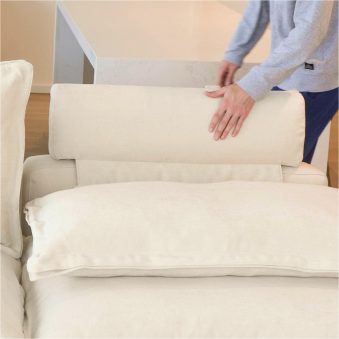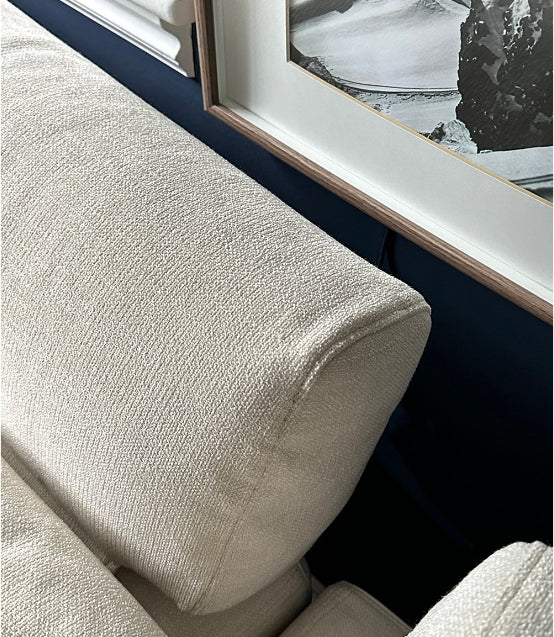Quick Answer
Yes, reclining sofas do need to be placed away from the wall. For a standard reclining sofa, you should leave at least 3 inches of space between the sofa and the wall behind it to allow it to fully recline without obstruction. It might require more room depending on the specific design of the sofa. However, the Homebody recliner offers a zero-clearance option and can be placed directly up against a wall. No additional clearance space is needed.

Introduction
Selecting the perfect reclining sofa involves more than just considering comfort—it's also about understanding how it'll fit into your living space. Many wonder if these sofas need a buffer from the wall to fully recline. In this guide, we're tackling that question head-on. We'll talk about the types of recliners that work best in snug spaces, share tips for measuring and arranging your room, and ensure you have all the know-how to relax in your home without cramping your style.
The Space Behind Reclining Sofas: Why It's Necessary
Space for Movement
Reclining sofas are designed to move; they extend backward and upward to give you that perfect spot to kick back and relax. If they're right up against the wall, they can't do their thing. You need to leave a little gap, usually at 2-3 inches, so when you push back, your sofa has the freedom to fully recline without any hitches.
Avoiding Damage
A bit of space behind your reclining sofa is also about protecting it—and your walls. When there’s no room, every recline scrapes or bangs into the wall, which can cause damage over time. The same goes for your sofa; constant hitting or rubbing on hard surfaces can wear down the upholstery or the reclining mechanism itself.
Cleaning Made Easy
Cleaning is a chore, but it gets easier when you can reach those dust-collecting spots behind furniture. That small gap between your sofa and the wall isn’t just good for reclining; it's also handy for the occasional sweep or vacuum, keeping your living area fresh and tidy.
How to Measure Up for Your Reclining Sofa
- Measure the Designated Area: Start by measuring the area where you plan to place your reclining sofa. Focus on both the width of the space and its depth, as the latter is crucial for accommodating the footrest when it's extended.
- Account for Extra Room: Ensure there's enough room in front of the sofa so that when the footrest is up, it doesn't bump into your coffee table or press against the wall.
- Consider Room Flow: Think about how the sofa will fit within the entire room. Check if it might block any walkways when reclined and if its size complements the rest of your furniture.
- Use Layout Tools: If you can, use layout apps or online tools to visualize how the sofa will look in your space. This helps to ensure it won't overcrowd your living area.
- Don’t Overlook Doorways: Measure the doorways and any other passages through which the sofa will need to pass to reach its destination. It's important to make sure it can get into your home!
- Aim for a Perfect Fit: Take the time to picture your new sofa in the room before it arrives. It’s important not just to fit the sofa in but to make sure it looks and feels as if it truly belongs in your space.
How to Set Up Your Reclining Sofa Without a Hitch
-
Doorway Dimensions: Before your sofa arrives, measure the width of your doors and any tight corners on the path to its final spot. You don't want to play a game of "Will It Fit?" with something that doesn't disassemble easily.
-
Clearance Check: Before you nestle that sofa in its new home, remember it needs room to stretch out. Always ensure there is sufficient space between the recliner and the wall to allow for a full range of motion when reclining.
-
Room to Move: Think about how the sofa will affect the flow of the room. Ensure it doesn’t block walkways when fully reclined and that there’s enough space to move around comfortably.
-
Maintenance Matters: Keep your sofa looking fresh by maintaining a safe distance from walls and other furniture. This prevents wear and tear and makes it easier to clean around and under it.
- Stay Level Headed: Make sure your recliner is on a level surface to avoid any uneven wear or stress on the moving parts. A little adjustment here can go a long way in extending the life of your sofa.
How to Place Your Reclining Sofa on Carpet and Hardwood Floors
Getting your new reclining sofa to fit in just right feels like the final piece of a cozy home puzzle, doesn't it? But before you kick back and relax, let's consider your floor type. Carpets and hardwood floors each have their quirks that can affect how your sofa reclines and lasts over time.
- Choose the Right Base for Carpets: If you have a thick carpet, opt for a recliner with a sturdy base or wide feet to prevent rocking. For thinner carpets, make sure the sofa doesn't shift when used, and adjust if necessary.
- Guard Your Carpet: Use furniture coasters under the legs of your sofa to help distribute its weight and avoid leaving deep marks on your carpet. Remember to rotate your sofa occasionally to prevent continuous pressure on the same area.
- Secure Your Sofa on Hard Floors: To keep your recliner from sliding on wood or laminate, fix non-slip pads to its feet. These pads also protect your floor from scratches and should be replaced when they wear thin.
- Prevent Floor Damage: Protect hard flooring surfaces by attaching felt pads to the sofa's feet. This minimizes scratches and enables easy movement when you need to clean underneath.
- Ensure Even Support: Make sure your recliner is level to avoid putting unnecessary strain on its mechanism. Adjust the legs as needed, especially if your floor is uneven.
Perfect placement is more than just dragging a sofa into position—it's about meshing comfort with care. With these tips, your recliner will be more than just a lounging spot; it'll be a smart, snug fixture that keeps your floors happy too.
The Bottom Line
Before you get your heart set on a new reclining sofa, grab that measuring tape to ensure a good fit in your room and through your doors. Choose between a wall-hugger or a traditional recliner based on how much space you have. Think about how the sofa will be used every day and pick one that stands up to the task while still looking great with your other furniture. When comfort meets practical design, you've found the perfect piece for your home.







